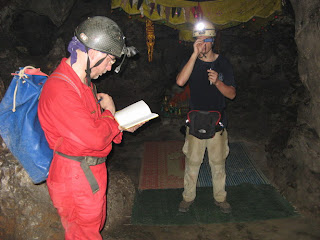My first blog on Battambang Caves is a general article. This page is specifically on the caves on Phnom Sampeu, which is the mountain visited by tourists. It is famous as it contains the killing caves and is a striking limestone outcrop with a wat on top.
During our caving expedition in June 2008, we stayed in Battambang in northwest Cambodia and drove out to the caves each day. Although the distances are not huge, travelling time was very long due to the appalling road conditions.
It took almost an hour to cover the 14 km to Phnom Sampeu. The road is very potholed and is dusty in the dry and full of small lakes in the wet.
At the car park they are building a large statue of Buddha. Work had started when I was there in 2004, and when I returned in 2008 there had not been much progress due to lack of funds.
As you walk up the hill on the long and winding road, you pass various shrines
Baby Buddha
Wat Mereoum
You reach the killing caves. This is where adults and children were pushed off the cliff top to fall down to the cave entrance. Some were bludgeoned or knifed before they were pushed, but many survived the fall and endured lingering deaths from starvation, thirst and injuries, as other bodies piled onto them.
In the cave where adults were killed there is now a shrine
and a display showing how the killings were done and asking for donations.
This was during the gruesome days of the Khmer Rouge massacres. An estimated 10,000 fell to their deaths here.
There are quite a few changes since my 2004 visit. For instance this Buddha and stupa were not there then
There is a nice view over to Crocodile Mountain
The path continues to the top of the hill, past new Buddhas,
and monks
At the top is a German field gun used by government troops against Khmer Rouge. There are macaque monkeys hanging around hoping for food.
A long staircase leads down to Diamond or Vishnu cave
At the top of the hill is a wat
and an apsara
There are more Buddhas and shrines as you start descending and come to Wind Cave
We surveyed all the caves
and the results have been published in the Atlas of Great Caves and Karst of SE Asia.
© Liz Price
No reproduction without permission


























No comments:
Post a Comment